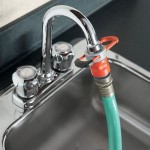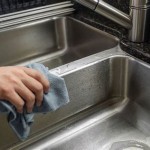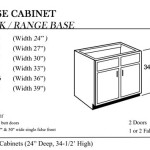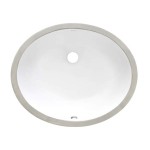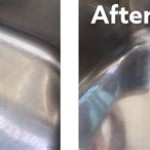Clogged Kitchen Sink Drain With Garbage Disposal: Causes, Solutions, and Prevention
A clogged kitchen sink drain, particularly when a garbage disposal is involved, is a common household problem that can range from a minor inconvenience to a major plumbing emergency. Understanding the causes of these clogs, how to address them effectively, and, most importantly, how to prevent them, can save homeowners significant time, money, and frustration.
The presence of a garbage disposal complicates the situation, as it introduces another potential point of failure and can grind food waste into a dense, difficult-to-remove mass. While garbage disposals are designed to break down food scraps, they are not invincible and can become easily overwhelmed by certain types of materials, improper usage, and a lack of maintenance. This article will explore the various factors that contribute to clogged kitchen sink drains with garbage disposal, provide step-by-step instructions for clearing common clogs, and offer practical advice on preventing future plumbing issues.
Common Causes of Clogged Kitchen Sink Drains with Garbage Disposal
Several factors can lead to a clogged kitchen sink drain when a garbage disposal is in place. Understanding these factors is the first step in preventing future problems.
Improper Food Disposal: The most frequent culprit is the improper disposal of food waste. Garbage disposals are not designed to handle all types of food. Certain items, when ground up, can create a sticky, congealed mass that quickly clogs the drain. Common offenders include:
- Grease, Oil, and Fats: These substances solidify as they cool, coating the inside of the pipes and trapping other food particles.
- Starchy Foods: Pasta, rice, and potatoes can expand when they come into contact with water, forming a thick paste that blocks the drain.
- Fibrous Vegetables: Celery, corn husks, and asparagus can get tangled around the disposal blades and create a stubborn clog.
- Eggshells: While some argue that eggshells help sharpen the blades, the membranes can stick to the sides of the drainpipe and catch other debris.
- Coffee Grounds: Coffee grounds can accumulate and solidify over time, leading to a gradual blockage.
- Bones and Hard Seeds: These materials are too hard for the disposal to effectively grind and can damage the blades or cause a jam.
Foreign Objects: Accidentally dropping non-food items into the garbage disposal is another common cause of clogs. Plastic utensils, metal bottle caps, glass shards, and other debris can jam the blades and prevent the disposal from functioning properly.
Insufficient Water Flow: Running an adequate amount of water while the garbage disposal is operating is crucial. The water helps to flush the ground-up food particles down the drain and prevents them from accumulating and solidifying.
Buildup of Debris: Over time, even with proper usage, food particles and grease can accumulate on the inside of the drainpipe, gradually narrowing the passageway and increasing the risk of clogs.
Plumbing Issues: In some cases, the clog may not be directly related to the garbage disposal itself. Issues with the plumbing system, such as a partially blocked drainpipe further down the line, can exacerbate the problem and make it more difficult to clear the clog.
Troubleshooting and Clearing a Clogged Kitchen Sink Drain With Garbage Disposal
When faced with a clogged kitchen sink drain with a garbage disposal, it is important to take a systematic approach to identify and address the problem. Before attempting any repairs, ensure that the power to the garbage disposal is switched off at the circuit breaker to prevent accidental injury.
Initial Assessment: Begin by checking the garbage disposal itself. Look inside the disposal chamber for any visible obstructions, such as large pieces of food or foreign objects. Use tongs or pliers to carefully remove any visible debris. Never reach into the disposal chamber with your hand, even if the power is off.
Resetting the Garbage Disposal: Many garbage disposals have a reset button located on the bottom of the unit. If the disposal is humming or making a clicking sound, but not grinding, it may have tripped the overload protector. Pressing the reset button can often restore functionality. Allow a few minutes before running the disposal again.
Using a Plunger: A plunger can be an effective tool for dislodging clogs in the kitchen sink drain. First, ensure that there is enough water in the sink to cover the cup of the plunger. If there is a double sink, seal the other drain opening with a wet cloth or a stopper. Place the plunger over the clogged drain and push and pull vigorously for several minutes. Remove the plunger and check if the water drains. Repeat the process if necessary.
Baking Soda and Vinegar: A mixture of baking soda and vinegar can often dissolve grease and other organic matter that is causing the clog. Pour about one cup of baking soda down the drain, followed by one cup of white vinegar. Let the mixture fizz for about 30 minutes, then flush the drain with hot water.
Boiling Water: For clogs caused by grease or soap buildup, pouring boiling water down the drain can sometimes be effective. Carefully pour a pot of boiling water down the drain and let it sit for a few minutes. If the water drains, repeat the process. If it does not drain, try using a plunger after pouring the boiling water.
Using a Drain Snake: A drain snake, also known as an auger, is a flexible tool that can be inserted into the drainpipe to break up or remove stubborn clogs. Carefully insert the drain snake into the drain opening and feed it down the pipe until you encounter resistance. Rotate the snake to break up the clog and then pull it back out. Repeat the process until the clog is cleared. Be careful not to damage the drainpipe with the snake.
Checking the P-Trap: The P-trap is the curved section of pipe located under the sink that is designed to trap debris and prevent sewer gases from entering the home. Sometimes, clogs can accumulate in the P-trap. To check the P-trap, place a bucket under the trap to catch any water. Loosen the slip nuts that connect the P-trap to the drainpipes and carefully remove the trap. Clean out any debris that is inside the trap and then reassemble it securely.
Professional Assistance: If none of the above methods are successful in clearing the clog, it may be necessary to call a professional plumber. Persistent clogs may be caused by more serious plumbing issues that require specialized equipment and expertise to resolve.
Preventing Clogged Kitchen Sink Drains with Garbage Disposal
Preventing clogs is always preferable to dealing with them after they occur. By adopting proper habits and maintenance practices, homeowners can significantly reduce the risk of clogged kitchen sink drains with garbage disposal.
Proper Food Disposal Practices: Adhering to a strict set of guidelines regarding what can and cannot be disposed of in the garbage disposal is essential. Avoid putting grease, oil, fats, starchy foods, fibrous vegetables, eggshells, coffee grounds, bones, and hard seeds down the drain. Dispose of these items in the trash or compost bin instead.
Adequate Water Flow: Always run cold water while the garbage disposal is operating. The water helps to flush the ground-up food particles down the drain and prevents them from sticking to the pipes. Continue running the water for a few seconds after the disposal is turned off.
Cut Food into Small Pieces: Before putting food scraps into the garbage disposal, cut them into small pieces to make it easier for the disposal to grind them effectively. This also reduces the risk of jamming the blades.
Regular Cleaning: Regularly cleaning the garbage disposal can help to prevent the buildup of debris and odors. One method is to grind ice cubes in the disposal. The ice helps to clean the blades and dislodge any accumulated particles. Another method is to pour a mixture of baking soda and vinegar down the drain, as described earlier.
Avoid Overloading: Avoid overloading the garbage disposal with too much food waste at once. Process food scraps in small batches to prevent the disposal from becoming overwhelmed and clogged.
Flush with Hot Water Periodically: Periodically flush the drain with hot water to help dissolve any grease or soap buildup that may be accumulating inside the pipes.
Use a Drain Strainer: A drain strainer can help to catch food particles and other debris before they enter the garbage disposal, reducing the amount of material that needs to be processed. Empty the strainer regularly to prevent it from becoming clogged.
Consider Enzyme-Based Drain Cleaners: Enzyme-based drain cleaners are designed to break down organic matter and can be used to help prevent clogs. However, it is important to use these products sparingly and to follow the manufacturer's instructions carefully. Avoid using harsh chemical drain cleaners, as they can damage the pipes and the garbage disposal.
Regular Plumbing Inspections: Schedule regular plumbing inspections to identify and address any potential problems before they become major issues. A plumber can inspect the drainpipes for signs of buildup or corrosion and recommend appropriate preventative measures.
By following these preventive measures, homeowners can significantly reduce the risk of clogged kitchen sink drains with garbage disposal and ensure the smooth operation of their plumbing system.

Clogged Kitchen Sink With Garbage Disposal How To Solve Quickly 3 Easy Fixes By Diynate Youtube

How To Fix A Clogged Kitchen Sink On Both Sides

How To Unclog A Kitchen Sink Drain

4 Easy Ways To Unclog A Kitchen Sink With Garbage Disposal

Most Effective Methods To Fix A Clogged Garbage Disposal

How To Unclog A Kitchen Sink Drain

How To Unclog A Garbage Disposal Diy Guide Affresh Appliance Care

Garbage Disposal Backing Up Into Sink Mr Rooter Plumbing

Common Causes For A Clogged Sink Brubaker Inc

How To Unclog A Kitchen Sink Youtube

